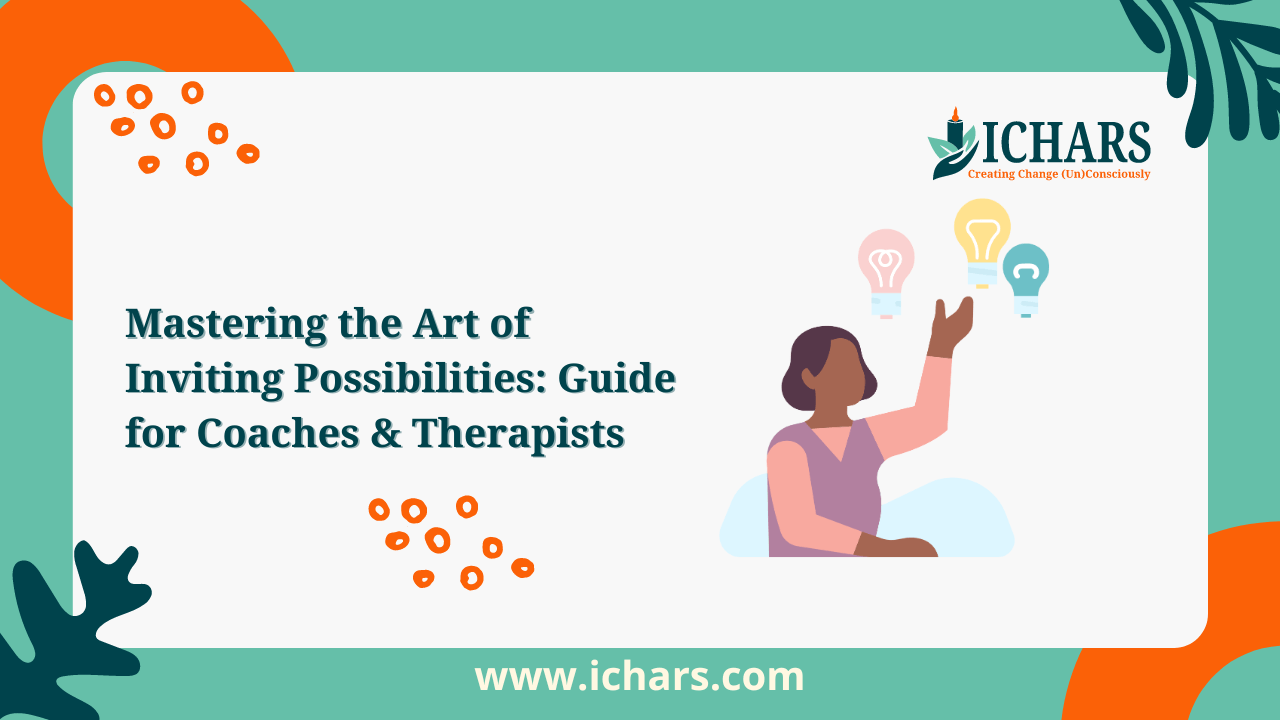Imagine a client who has been stuck in a cycle of self-doubt and fear, unable to see a way forward. Despite various interventions, they remain anchored to their limitations.
As a psychologist or coach, how often have you encountered such scenarios?
How do you help clients unlock their potential when they can’t see beyond their current state?
In this article, we explore the transformative competency of Inviting the Possibility through Cognitive Hypnotic Coaching and Psychotherapy. We delve into innovative techniques and practical strategies to help you guide your clients toward new horizons of growth and change.
Understanding the competency of ‘Inviting Possibilities’

Inviting the possibility is a powerful capability within coaching and therapy, demanding an artful blend of questioning, insight, and strategizing. This competency involves guiding clients to envision alternative pathways and perspectives, fostering a sense of hope and potentiality that may have been previously unseen.
By helping clients shift their focus from limitations to opportunities, engage in imaginative exercises, and dissolve mental blocks, practitioners can transform feelings of stagnation into momentum.
The Importance of Cognitive Hypnotic Coaching and Psychotherapy
Cognitive Hypnotic Coaching and Psychotherapy is an integrative approach that seamlessly combines hypnosis with various psychotherapeutic modalities. This approach leverages the power of the subconscious mind to facilitate deep and meaningful change.
By using hypnosis as a foundational tool, CHCP enables practitioners to access and address underlying psychological issues more effectively, making the competency of inviting the possibility a central tenet of transformative client work.
Techniques for Inviting Possibilities in CHCP

- Revelation Metaphor
Revelation metaphors are powerful tools for illuminating new perspectives and insights. These metaphors use storytelling and analogies to reveal deeper truths about a client’s situation in a non-confrontational manner.
By presenting ideas symbolically, revelation metaphors bypass resistance and allow clients to see their issues from a fresh viewpoint, opening up new possibilities for change. - Introspection Metaphor
Introspection metaphors facilitate deep self-reflection by using symbolic language that resonates with the client’s inner experiences.
These metaphors encourage clients to explore their thoughts and behaviours on a profound level, leading to personal insights and increased self-awareness. This technique is especially useful for clients who struggle to articulate their inner conflicts directly. - Transformational Metaphor
Transformational metaphors guide clients through the process of change by symbolically representing their journey within the narrative.
These metaphors help clients visualize their transformation, making the abstract process of change more tangible and achievable. By embedding the transformation within a story, clients can more easily internalize and act upon the new possibilities presented. - Subconscious Talks
Subconscious talks involve direct communication with the client’s subconscious mind, often facilitated through hypnosis.
This technique allows practitioners to bypass the conscious mind’s defenses and engage with the deeper layers of the psyche where core beliefs and patterns reside. Subconscious talks can uncover hidden motivations, resolve internal conflicts, and instill new, empowering beliefs. - N-Step Reframing
N-Step Reframing is an NLP technique that helps clients reframe unwanted behaviours or thoughts by identifying their positive intentions and finding alternative ways to achieve those intentions.
This process involves several steps, including eliciting the behaviour, identifying the positive intent, creating alternatives, and integrating the new choices. By reframing in this structured manner, clients can shift their perspectives and open up to new possibilities. - Perceptual Positioning
Perceptual positioning allows clients to view situations from different perspectives: their own, another person’s, and an observer’s. This technique is particularly helpful in resolving conflicts and enhancing empathy. By stepping into different viewpoints, clients can gain a more comprehensive understanding of their issues and discover new ways to approach them. - Higher Self and Inner Advisor
Connecting with the higher self or an inner advisor involves accessing a more enlightened and intuitive aspect of oneself during a hypnotic state. This technique provides clients with profound wisdom and guidance that transcends their everyday consciousness.
By consulting their higher self or inner advisor, clients can gain clarity and direction, making it easier to invite and embrace new possibilities. - Spirit Guides
Spirit guides are another resource within the client’s subconscious that can offer support and insights. By establishing a connection with spirit guides, clients can receive guidance that feels both personal and transcendent.
This technique can be especially comforting and empowering, providing clients with a sense of companionship and direction on their journey toward change.
Enhancing Your skills for ‘Inviting Possibilities’
To effectively help clients explore and embrace new possibilities, practitioners need to enhance specific skills that promote openness and foster a future-oriented mindset. Here’s how techniques from Cognitive Hypnotic Coaching can be employed to develop this competency.
- Cultivating Open-mindedness
Embrace and model open-mindedness to inspire clients to consider diverse perspectives and solutions they may have previously overlooked. - Expanding Client Vision
Utilize visualization techniques to help clients create vivid, compelling images of future success, stimulating motivation and a sense of direction. - Strategic Use of Hypnotic Language
Employ hypnotic language patterns to introduce new possibilities into the client’s subconscious, making them seem more achievable and realistic. - Employing Metaphors
Craft metaphors that parallel the client’s experiences, using them as tools to suggest alternative narratives and outcomes. - Solution-focused Questioning
Incorporate solution-focused questioning strategies that encourage clients to think about the ‘how’ of achieving their goals, rather than getting stuck on the ‘if.’ - Counterfactual Thinking
Guide clients in considering ‘what if’ scenarios to challenge limiting beliefs and encourage a more expansive view of their options. - Building Resiliency
Teach clients resilience-building techniques that foster a positive response to setbacks, nurturing a proactive approach to creating new opportunities.
By enhancing these skills within your practice, you equip clients to break free from restrictive thought patterns and pave the way for innovation and transformation in their lives.
Applying ‘Inviting the Possibility’ in Your Practice

Incorporating the ‘Inviting the Possibility’ competency into coaching and therapy involves more than just encouraging optimistic thinking; it’s about actively facilitating clients’ ability to envision and strive for alternative, positive outcomes. Here is how Cognitive Hypnotic Coaching techniques can be applied in practice.
- Structured Visioning Exercises
Introduce exercises that guide clients through the process of clearly visualizing desired futures, using all senses to enhance the experience and solidify the vision. - Creative Problem-Solving
Facilitate brainstorming sessions where clients feel free to explore creative solutions without judgment, using mind mapping or other ideation tools. - Reflective Journeys
Invite clients to reflect on hypothetical scenarios where they have overcome current challenges, fostering a belief in their capacity to change. - Belief Challenging
Challenge existing limiting beliefs by presenting alternative viewpoints and evidence, leveraging cognitive restructuring techniques. - Resource Anchoring
Use NLP anchoring techniques to help clients access states of confidence and resourcefulness, empowering them to face challenges with a renewed perspective. - Goal Setting Workshops
Organize sessions focused on setting achievable yet aspirational goals, breaking down the process into actionable steps. - Therapeutic Storytelling
Engage clients with stories that illustrate the power of change and the potential for personal growth, aligning these narratives with their own experiences.
By skillfully applying these CHC techniques, coaches and therapists can open a world of new possibilities for clients, helping them to navigate transition points with a sense of hope and capability.
Overcoming Roadblocks to Mastery
Working with clients to invite new possibilities can sometimes be met with resistance, skepticism, or fear from both the client and the coach or therapist. Understanding these challenges and having an array of strategies to navigate them is critical. Here are some roadblocks and Cognitive Hypnotic Coaching techniques to address them.
- Client Resistance to Change
Challenge: Clients may resist exploring new possibilities due to fear or discomfort.
Solution: Employ reframing techniques and gradual exposure to new ideas to minimize fear responses and encourage openness. - Practitioner Bias
Challenge: Coaches and therapists may unintentionally project their own beliefs and limitations onto the client.
Solution: Engage in self-reflection and supervision to ensure personal biases are recognized and managed. - Overwhelm with Options
Challenge: Clients may feel overwhelmed when considering multiple new avenues.
Solution: Utilize chunking and prioritization strategies to simplify choices and focus on manageable possibilities. - Lack of Immediate Results
Challenge: Clients, and sometimes practitioners, expect immediate results, leading to frustration.
Solution: Set realistic expectations for the process of change and celebrate incremental progress with clients. - Maintaining Motivation
Challenge: Sustaining the motivation to pursue new possibilities can wane over time.
Solution: Incorporate regular follow-ups and reinforcement of achievements to maintain momentum.
By adeptly addressing these roadblocks, practitioners can more effectively assist clients on their journey toward embracing new, life-enhancing possibilities.
Conclusion
The therapeutic competency of Inviting Possibilities serves as a beacon for those navigating the seas of uncertainty and hesitation. It empowers clients to venture beyond their perceived limitations, fostering a realm of potential where new paths and outcomes become attainable. This essential skill for coaches and therapists holds transformative power, aiding in the journey from stagnation to growth, from doubt to discovery.
Training and continuous skill development, as offered by programs like the Cognitive Hypnotic Coaching and Psychotherapy Diploma, provide the necessary acumen to guide this exploration effectively. Embracing the methodologies of CHC can elevate a practitioner’s ability to navigate this competency with finesse, unlocking clients’ full potential and reinforcing the path toward actualizing their goals and aspirations.
The journey of inviting possibilities is ongoing, a testament to the never-ending quest for personal evolution and professional excellence. As we conclude, it is a clarion call to all practitioners to deepen their perspectives, expand their therapeutic toolkit, and continue shaping lives with the power of possibility.

